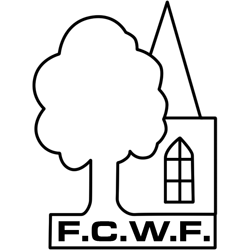Childwall Woods has remained largely unchanged since they were planted in the 1700s, however, through the years their name has changed as have their owners. The woods were originally the grounds of Childwall Hall the seat of a wealthy landowner and were known as The Grounds. They extended from Childwall Abbey Road to The Black Wood, which goes back to the 1600s.
The area from Childwall Lane up to Childwall Woods is known today as Childwall Fields. Over a hundred years ago this area was known as Childwall Park, a name that has gone from the fields but lives on in Childwall Park Road, nearby. Childwall Park was different in every way from Childwall Fields, its transformation taking decades and continuing today.
Childwall Hall
The Owners – A Family Tree
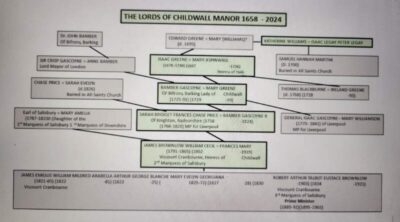
The Owners of Childwall Hall and Manor. (Shown in green)
There has always been some kind of Manor House associated with Childwall going back to the 1600s and it has had a long list of owners. It is recorded that the Earl of Derby owned the manor known as Childwall in 1614 but during the Civil War, his lands were taken by parliament. The Earl managed to regain ownership years later only to sell some of his lands to raise funds to clear his debts. Documents show that Childwall Manor, occupied at the time by Isabel Houghton in August 1657, was sold or rather mortgaged to Dame Elizabeth Finch and Edward Bagnell.
Elizabeth and Edward did not own the manor for long. On 14th October 1658, it was again sold for £4,700 to brothers Peter and Isaac Legay, who are described as Merchants of London. The following year Peter relinquished his right to the manor and Isaac Legay became the sole owner.
Isaac Legay remained the owner until his death in 1680 when the lands and the house went to his son Samuel Legay who himself died ten years later in 1700, leaving the land and the house to his 2 sisters Hannah Hollis and Martha Solly. Having no use for the manor and land themselves they sold them in 1718 to Isaac Greene of Prescot, a wealthy attorney practising in Liverpool.
Isaac Greene married Mary Aspinwall, daughter and heir of Edward Aspinwall of Hale, and became Lord of Hale as well as of the manors of Childwall, Wavertree, Much and Little Woolton, West Derby, Everton and Eltonhead.
It seems to have been at this time that many trees were planted around the hall, creating The Grounds, and further afield to create areas for hunting.
Isaac had 3 daughters and a son, but only 2 of his children lived to inherit his wealth on his death in 1749. Mary, the younger of the surviving siblings inherited half of her father’s land including Childwall Hall and its grounds.
Mary Greene (1729-1799) married Bamber Gascoyne (1724-1791), son of Sir Crisp and Anne Gascoyne (Gascoigne) in 1757. The name Bamber was Anne Gascoyne’s maiden name and it lived on in the family for many generations. Mary and Bamber went on to have 2 sons, the first son, also named Bamber, was born on 26th November 1757.
The Yates and Perry map of the area in 1768 shows Childwall Heath as the area west of Childwall Hall. Trees can be seen around the hall and by the road to Woolton where the Black Wood stands today. At this time Isaac and Mary had passed away, and their estate held by their daughter Mary and her husband Bamber Gascoyne Snr. Bamber Junior was still just a boy.
From the age of the beech and sweet chestnut trees in Childwall woods today it is apparent they were planted roughly 250-300 years ago, around the time that Isaac and Mary moved to the hall. Thank you, Isaac and Mary, for initiating our beautiful Childwall Woods.
Bamber Gascoyne Jnr (1757-1824), son of Mary and Bamber Snr, married Sarah Bridget Francis Price (1766 – 1820) and took a career in politics becoming a member of Parliament for Liverpool in 1780. His brother Isaac replaced him in 1896 as MP for the next 35 years.
When Bamber inherited the estate he decided the hall was not to his liking and demolished it to build a new castellated hall to the design of the popular architect John Nash who had a hand in the design of Buckingham Palace. Nash was reluctant to take private commissions but was persuaded by Bamber Jnr to rebuild Childwall Hall to look very similar to Nash’s own home, East Cowes Castle. Nash worked on Childwall Hall from 1806 to 1813 transforming it into a gothic castle, like his own. Looking more like an ecclesiastical building than a Hall, the locals nicknamed it, The Abbey
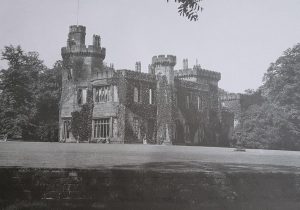
Childwall Hall. Transformed into a mock Gothic Castle
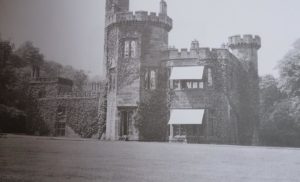
Photograph donated to FCWF by Mr Ray Lowe whose family once lived in the second lodge.
The new Childwall Hall was built from the local Bunter Sandstone and no expense was spared. There were local quarries nearby and there was the sandstone quarried out from the carriageway, making materials readily available.
Bamber Jnr had a love of books and a huge library was built in the new Hall, along with a billiard room, drawing room, dining room and study. An oak Gothic Sarcophagus took pride of place amongst the ornate furnishing, making this an extravagant show of wealth.
There had always been a track from the main gates to the Hall, it was visible on the early maps, but now a wonderful curved carriageway was cut into the sandstone to carry important visitors to the newly built Hall.
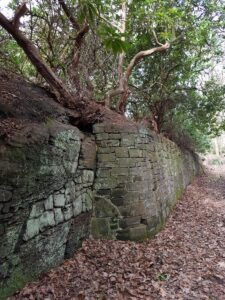
Was the carriageway cut or built, or both?
Within the grounds, an ornamental woodland walk was created through sunken gardens we now call the Folly, (Monkey Island to locals). Planted with evergreens and unusual trees, what a wonderful spectacle it would have been in its day. All this was designed to showcase the wealth of the owners and impress the many visitors entertained there. Bamber spent so much time entertaining, that he was asked to step down from his seat in 1796 due to his many absences from parliament.
A hall so grand with a carriageway needed a gatehouse, and in 1807 a castellated lodge was built by the main gates where visitors would enter. Also designed by John Nash it still stands today as a Grade 11 listed private residence on Childwall Abbey Road but its origins are clearly visible.
Another lodge was built on the path from the Hall to Woolton Road and visitors on foot would have had to walk through its central archway. It no longer stands but its remains can be found on the woodland floor by those who care to brush the leaves away.
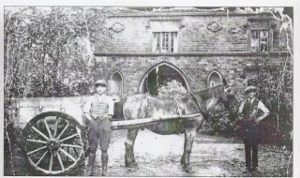
A rare photo of ‘labourers’ outside the second lodge
The grandson of one of the hands who worked in the stables visited the site of the second lodge recently and recalled stories told by his father who was born there. His grandmother grew most of their vegetables in the small patches of land around the lodge, supplemented by foraged mushrooms, and his grandfather would hunt for pheasant and rabbits in the grounds. Not many rabbits or Pheasants around there these days but you might still do a bit of foraging if you know what to look for.
Bamber Jnr died on 17th January 1824 and his only child, a daughter Frances Mary (1802-1839) inherited the Hall and grounds. Shortly before his death Bamber took Frances to London where he knew she would meet rich, eligible gentlemen, and his plan worked. Frances met Viscount Cranborne, the Second Marquess of Salisbury on that visit and they married soon afterwards in February 1821. Frances never lived at Childwall Hall again. She moved to her husband’s home in London but was not happy with city life and told friends that she missed Childwall, however Frances and her husband spent some of the autumn seasons at the hall.
The hall was leased to 4 families and Childwall Golf Club from 1836 for the next 102 years.
Follow this link for details of The Tenants of Childwall Hall.
The Hall became empty in 1938 when its final tenants Childwall Golf Club moved out. They had rented the hall from 1922 to 1938 when they moved to their present site in Gateacre, leaving the hall empty.
Liverpool Corporation bought 50 acres of its parkland from the owner for £10,000 in 1939 and was given the hall and 4.5 acres as a gift. It was planned that the house would be used as a college, however, it was not a good design for a college and when it was found to be riddled with dry rot in 1949 it was demolished.
A college was later built on its site and the woodlands were fenced off from the college in 1960. It was then open to residents and 6 years later in 1966, the woods were opened to the public. Childwall Woods was born.
Below is an article from the Liverpool Echo in 1967 when a commemorative tree was planted to mark the opening of the woods to the public. The article states that Lord Cranborne, the grandson of the Marquis of Salisbury, the original owner, was there at the opening.
It is very interesting to read that the tree, a ‘purple-leafed beech’ was given to the Liverpool corporation by Mr George Mellor, who was the Chairman of the Childwall Woods Preservation Society, and watching was the Vice-Chairman Mr F Howard Andrews. This certainly sounds like a predecessor of Friends of Childwall Woods and Fields.
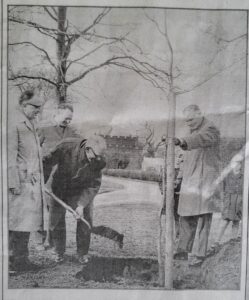
The Commemorative Tree, a purple-leafed beech.
The college was sold in 1990 to Mersey Television which later became Lime Pictures, and they are the owners of the land today.
In 2004 the grounds, together with the Black Wood, were recognised as being an important habitat for wildlife and were designated by the city council as a Local Nature Reserve.
The photographs below show the celebration that was held to mark this achievement. Thanks to Diane Jones for contributing these. Di tells us that this took place in the area just behind the commemorative tree as you walk through the main gates on Childwall Abbey Road.
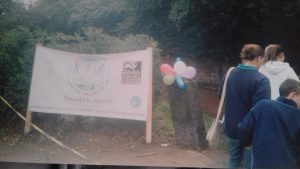
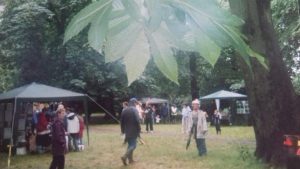
The woods and fields are still owned by Liverpool Council but this 39-acre site is now part of the Mersey Forest and managed in partnership with, Lancashire Wildlife Trust, Liverpool City Council and Friends of Childwall Woods and Fields.
Childwall Fields
The area that we know as Childwall Fields was once known as Childwall Park and was a gentle grassy slope up from Childwall Lane to the border of Childwall Woods, looking very different to the Childwall Fields that we know today. Its original entrance used to be on Childwall Lane but was boarded up many years ago. With just a few trees on the gentle slope, it looked nothing like the fields we see today.
The lower northern corner of the fields, next to Childwall Lane, used to be the site of the village cross and is clearly shown on the 1904 map, but was moved and today the cross stands proudly on Childwall Lane, overlooking the pedestrian loop of Crossways. Childwall Park became Childwall Golf Club in 1922 when the hall was rented by Childwall Golf Club and the bunkers bear witness to this on the aerial photo higher on the page.
Throughout World War 2 the land known as the fields was used to grow vegetables and essential food crops that were in short supply. After the war had ended the fields changed again but now to pasture for sheep. Still the gentle slope up to the woods.
In the 1960s the slope disappeared under hundreds of tons of garbage when the area was used as a huge landfill site which continued into the 1970s.
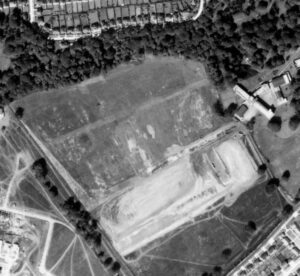
Tipping eventually stopped and after burning off as much as possible the site was allowed to settle and the 3 fields we see today were created. The reason for defiling this gentle slope was to create three level areas that could be used by the college as football pitches. The fields were capped with clay and then covered with a layer of soil before being used for a short time as sports fields, but when the college was sold to Lime Pictures, the fields were given back to nature, and an amazing variety of grasses, wildflowers, bushes and trees now cover this site, disguising what lies beneath.
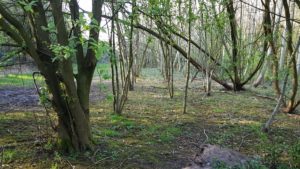 In the 1980s the Fields became the focus of the research done by PhD students from Liverpool University who took on the challenge of planting a variety of trees to see which species would grow best if any, on a former landfill site and the mixed plantation on the SE part of the middle field was created.
In the 1980s the Fields became the focus of the research done by PhD students from Liverpool University who took on the challenge of planting a variety of trees to see which species would grow best if any, on a former landfill site and the mixed plantation on the SE part of the middle field was created.
Childwall Fields was one of 12 former landfill sites in the region that was planted for research purposes and 30 years later has proven to be one of the best. The whole area has now matured into the perfect habitat for various animals, birds, flora and fauna, as well as becoming a wonderful asset to the community.
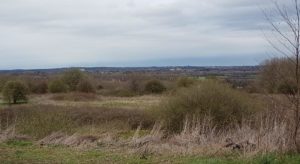
The 3 fields have quite different characters, with the top field being the most friendly for walkers and offering a spectacular view across Lancashire.
Childwall Woods and Fields has grown into a treasured amenity that its original creators could never have imagined it would become. This beautiful Local Nature Reserve that was once the grounds of a stately home has been taken back by nature giving us a wonderful opportunity to glimpse the beauty of the natural countryside. It is managed yet it is wild, is in the city yet in the countryside, is the same as it was but is everchanging and must be preserved for generations to come.
B Cameron 2024
Acknowledgements
Childwall Hall | History of Childwall – Jonathan Wild

